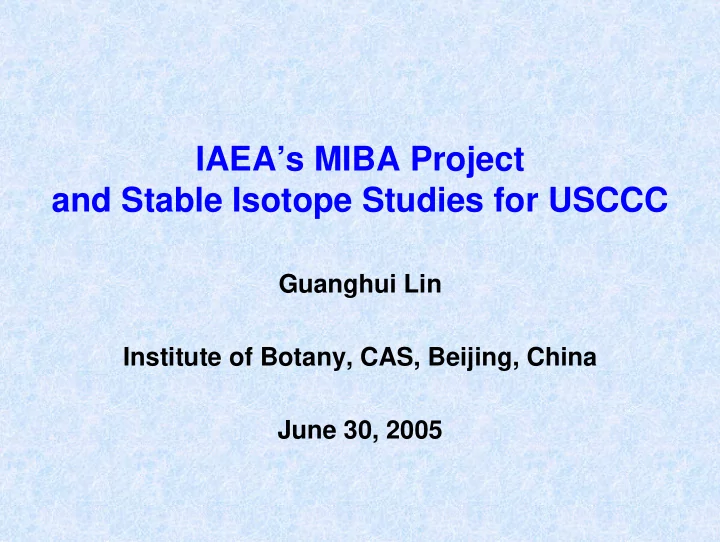

IAEA’s MIBA Project and Stable Isotope Studies for USCCC Guanghui Lin Institute of Botany, CAS, Beijing, China June 30, 2005
Outline � The MIBA network overview � USCCC contributions to MIBA � Stable isotope studies for USCCC
The MIBA network � MIBA: Moisture Isotopes in the Biosphere and Atmosphere � Established at a meeting in Vienna in May 2004 � Building on GNIP (& GNIR) in collaboration with WMO � Primary aim - to facilitate acquisition of data on stable isotopes in biospheric and atmospheric water � Funded mainly by IAEA (for minimum 10 years)
MIBA objectives � Regional scale hydrological budgets � The partitioning of annual carbon fluxes � The development of new global change indicators � Ecosystem functioning � Interpretations of 13 C and 18 O analyses in organic matter � The validation of general circulation models � Past global responses to climate change
Idealized distribution- 100 sites: 90 continental, 10 oceanic (water vapor) 15 15 15 15 15 15
MIBA sites so far (May 2005) ht t p: / / w w w - naw eb. i aea. or g/ napc/ i h/ M I BA_w eb/ m i ba. ht m
IAEA Membership � P. Aggarwal, Head, Isotope Hydrology Section IAEA � D. Yakir (Israel; Chair), G. Farquhar (Australia), A. Henderson-Sellers (Australia), L. Flanagan (Canada), F. Longstaffe (Canada), G. Lin (China), J. Santruek (Czech Republic), P. Ciais (France), G. Hoffman (France), W. Stichler (Germany), H. Meijer (the Netherlands), R. Siegwolf (Switzerland), N. Buchmann (Switzerland), H. Griffiths (UK), J. Berry (USA). P. Tans (USA), L. Sternberg (USA), T. Dawson (USA), J. White (USA), and Brent Helliker (USA)
IMPLENETATION OF MIBA PROJECT � The IAEA will facilitate the work of MIBA group � Participants of worldwide will collect leaf, stem, soil and vapor water samples biweekly for 10 years; � MIBA group will assist in providing training and logistics according to needs; � The IAEA isotope laboratory and that of several group members will provide free isotopic analyses;
Where : Preferably at flux-net-tower sites or similar When : year around for evergreen forests or during the vegetative period of temperature forests or grasslands How often : Every two weeks How : Fill the sample tubes and seal as soon as possible What time of the day: between 12:00 and 16:00 (solar time) Weather conditions: No rain, no water on the leaves and stems
USCCC contributions to MIBA � Routinely sampling and analyzing vapour isotopic compositions in Beijing suburb (weekly) � Sampling soil, stem and leaf waters bi-weekly for δ 18 O analyses in grass, desert, plantation, crop field, forest ecosystem across China � Extracting water samples from the above specimen for stable isotope analyses (in IAEA Isotope lab) � Organizing at least one network annual meeting for participating members (2007 or 2008)
R oof m oi st ur e sam pl i ng at I B_C AS St ar t ed on Apr . 19, 04, and w i l l r epeat w eekl y. . . .
SILEER (Stable Isotope Lab for Ecological and Environmental Research) I AEA ’ s desi gnat ed i sot ope l ab f or M I BA pr oj ect i n C hi na
MIBA_China Sites CN_12 CN_10, 11 CN_8, 9 CN_7 CN_6 CN_4, 5 CN_1, 2, 3
MIBA_China Project Management Project Investigators: Prof. Shuqing An Prof. Xudong Zhang Prof. Bo Li Prof. Zhiqiang Zhang Dr. Guanghui Lin Dr. Guangsheng Zhou Project Coordinator: Dr. Guanghui Lin (010-82593840;ghlin@ibcas.ac.cn) Project Assistant: Ms. Ying Xiong (010-62599059;yxiong2003@ibcas.ac.cn) Project technical support: Mr. Leyi Li (010-62836277; lileyi@ibcas.ac.cn)
A possible manuscript Title : Relationship between isotopic signals and ecosystem water use efficiency in selected ecosystems of China Authors : All USCCC site PIs, key associates/students Data needed : A few weeks of NEE and ET data at each site Isotopic ratios of leaf and water samples (IAEA) δ 13 C of ecosystem or soil respired CO 2 (selected sites) Targeted journal : PCE or New Phytologist
CO 2 Trapping System � For δ 13 C r � ecosystem WUE � For NEE partition:NEE � A+R; R=R A +R H Xi l i nhot si t e ( Fenced gr assl and)
- 8. 0 y = 4565. 3x - 21. 206 δ 13 C r � W 2 = 0. 9595 R U E - 9. 0 e - 10. 0 δ 13C( ‰ ) - 11. 0 - 12. 0 - 13. 0 August 2004 - 14. 0 0. 0018 0. 002 0. 0022 0. 0024 0. 0026 0. 0028 0. 003 ol μ m - 1 ) 1/ CO 2 ( m ol - 8 y = 5779. 7x - 24. 66 2 = 0. 9586 R Sept em ber 2005 - 9 δ 13C( ‰ ) - 10 - 11 - 12 - 13 Sun, C hen and Li n, 0. 002 0. 0022 0. 0024 0. 0026 0. 0028 0. 003 ol μ m - 1 ) 1/ CO 2 ( m ol unpubl i shed dat a
Vapor Trapping System (for ET partition)
M esqui t e w oodl and, U SA Yepez et al . ( 2003)
Evapotranspiration at mesquite site, 2001 Yepez et al 2003 Yepez et al 2003
Other topics for isotope study � NUE and N cycles in ecosystem � Differential water use patterns � Plant-animal interactions � Sources and fate of trace gases (CH 4 , N 2 O)
Recommend
More recommend